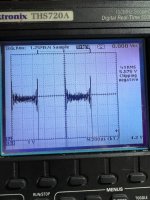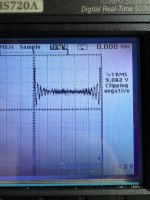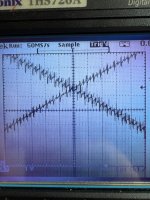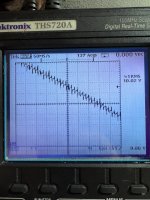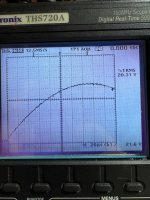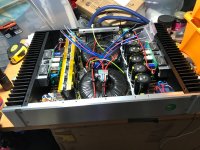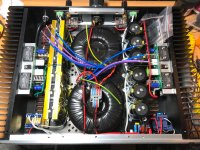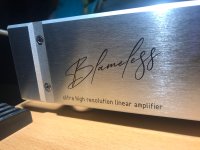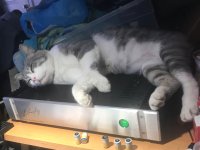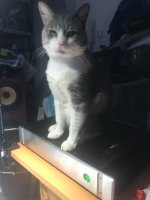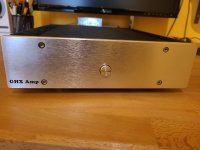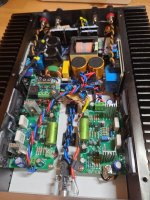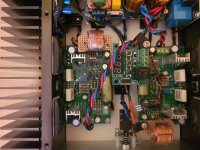I would consider at least a 300va 30-30vHello all,
I have a little issue with my build 4.2 board.
No humm but a slight buzz from a spealker and when I play musique, I get a slight crakling, popping noise and distortion.
1 - I use a chinese SMPS, could the SMPS be the issue?
2 - I was thinking going for a toroid transformet with a rectifier board. Is 30VA enaught or should I go higher?
Thanks
It all depends on your speakers and your power requirements.
I am using a 500va 30-30 with 90000uf PSU rectifier.
@dakku
In your schematics you don't draw signal grounds, which are essential to spot the real source of your problem. Just draw the signal grounds and you'll see a huge ground loop that you have created. You should connect your both signal grounds at a single point. I bet you have connected left channels' ground to the left channel board and right channels' signal ground to the right channel board. That is wrong: either-or, not both. Go back to the @digi01 post #7 and try to learn.
View attachment 1409882
HUH, pure waste of time. Just @digi01 posts are relevant.
ALL other posts of that thread is ordinary bulshit, Safety-Earth-Police yaddah-yaddah.
Let me explain you how to solve this problem.
Refer to the wiring diagram in my previous post #1.015
1. Your RCA connectors should be as close as possible to each other.
2. Solder the RCA grounds to each other with a short wire and use one wire to connect the RCA ground to the star ground
3. Connect just the signal of the RCAs to INs at the board and do not connect anything to the input GND on the board. Your input grounds are now connected to the star ground via one, single, wire. That is essential.
4. Connect grounds of the both channels to the star ground with a THICK wire to ensure the lowest possible resistance.
Thats all.
Sir please can you check if this is a correct depiction of what you mentioned:
updated to include a ground to chassis using 10ohm resister in series.

- Star Ground:
- The PSU star ground is used as the central reference point.
- All grounds (amps, RCA, speaker protect module) terminate at this star ground.
- RCA Ground:
- The RCA connectors share a common ground that connects directly to the star ground.
- The amplifiers are connected to the star ground, not directly to the RCA ground.
- Amplifier Grounds:
- Both amplifiers use the star ground as their reference
- Signal ground (from RCA) flows to the star ground and then to each amp ground.
- Speaker Protect Module:
- Each channel of the speaker protect module connects to the corresponding amp’s ground and outputs.
- Ground is isolated for each channel, avoiding direct ground sharing between left and right.
- Chassis Ground:
- The chassis is connected to the PSU star ground via a 10-ohm resistor.
- The chassis is also connected to the mains earth
Last edited:
Sir please can you check if this is a correct depiction of what you mentioned:
@dakku, first, we are all friends here - there is no need to refer to anyone with "Sir". Though, I understand that as a habit of a courteous gentleman.
Correct, except connection to the input onboard "GND" should not be connected. Your signal input ground is already connected to the board ground. You can verify this with multimeter continuity check.
There is no need for duplicate connection of the input "GND" through an alternative route. (Occam's razor)
Below is a wiring diagram from the internet by Scott Campbell published in his great article entittled "A Complete Guide to Design and Build a Hi-Fi LM3886 Amplifier".
Go and read it - there is plenty of useful information in this article even though it is about another amplifier configuration. Basics of wiring are the same.
Last edited:
Well, as I mentioned above, I ordered the transistors as per LJM suggestion, to treat the v5 amp instability. The transistors ordered from the UT Source, sold as "ut source new", that mean that factory sealed package with devices was opened at UT warehouse. The transistors are Toshiba. I replaced 2 transistors that LJM recommended to replace in email, and the screen of the oscilloscope is better than 1000 worlds.
Power supply is 500w LLC SMPS
Power supply is 500w LLC SMPS
Attachments
Last edited:
Prior to testing, I adjusted bias to 3.5mV, than I allowed an amp to cool down for 10 minutes, and rechecked the bias - it was 2.5mV.
Well, looking at the difference of the Bryston B2 and B3, or Classe ca5200 and Delta Stereo, I just see, that instead of creating many trash clones, designers working to improve already great designs, and releasing it after careful testing.
Is it possible to create $4000-10000 performance on $20 boards? Just look at the Compact Blameless amp, which costs the same as l12-2, or Cosmos ADC, which costs $200, but it is a good piece of performance of AP analyzer, that costs 10 times more.
The problem with 12-2 is irresponsibility, -the worst problem possible. Sell to customers just faulty boards, without deep checking of stability and reliability is nothing other than a shame.
After ending to write this, I rechecked the bias, it "floated" to 3.1 mv...
Well, looking at the difference of the Bryston B2 and B3, or Classe ca5200 and Delta Stereo, I just see, that instead of creating many trash clones, designers working to improve already great designs, and releasing it after careful testing.
Is it possible to create $4000-10000 performance on $20 boards? Just look at the Compact Blameless amp, which costs the same as l12-2, or Cosmos ADC, which costs $200, but it is a good piece of performance of AP analyzer, that costs 10 times more.
The problem with 12-2 is irresponsibility, -the worst problem possible. Sell to customers just faulty boards, without deep checking of stability and reliability is nothing other than a shame.
After ending to write this, I rechecked the bias, it "floated" to 3.1 mv...
Thanks Tolik,...oscilloscope is better than 1000 worlds...
As I have expected, LJM offered a "great" advice. This reminds me of my dear friend Billy from Newcastle-upon-Tyne who purchased 10 LJM L20.5 and all of them have suddenly/randomly burned. LJMs excuse was that he hasn't tightened output devices firm enough. But of course. There is always a perfect explanation that everything is other peoples fault.
We’re talking about a bit different things.I can imagine that the monkey who assembled the boards was not careful in those and forgot to tight all the screws, but in our case is an entire design is faulty. It’s not a fault of LGM assembly guy, it is LJM personal irresponsibility. Irresponsibility in best case
@TolikWe’re talking about a bit different things.
I think it is the same thing: complete absence of responsibility, as you properly identify it. Billy has tightened output devices properly and, by the way, L20.5 doesn't dissipate enough heat to cause thermal runaway. I'm sure LJM knew that, but he is a master of blameshifting. If nothing else works he shifts to Chinglish or remains silent for a while until things settle a bit.
BTW: Where can I purchase Compact Blameless amp? At Douglas Self "The Signal Transfer Company"?
... Just look at the Compact Blameless amp, which costs the same as l12-2 ...
it is more than enough to shift me, and probably not me only, to amplifiers, designed by the masters of electronic engineering. But I want to perform one last test: with linear power supply, that I built for that project already, and there still one A1837 transistor on board, that I can to replace with the Toshiba device.I'm sure LJM knew that, but he is a master of blameshifting.
I also got V4.2 boards, so it will be interesting to how they are performing.
Finally solved my problem. The 3 screws where touching my case.
Isolated them and no more crackling sound.
I have a very faint hiss with my ears on the speaker but nothing serious.
It should be noise from the smps. My speakers are 93db.
Isolated them and no more crackling sound.
I have a very faint hiss with my ears on the speaker but nothing serious.
It should be noise from the smps. My speakers are 93db.
I just found this on AliExpress: ₪143.93 | Ghxamp HIFI Classic Discrete Amplifier Board Audio AMP 35V/us By "Audio Power Design Manual" 2SC2922 Dual 24V-Dual 50V 1PairsBTW: Where can I purchase Compact Blameless amp?
https://a.aliexpress.com/_oCyVd97
I just found this on AliExpress: ₪105.32 | Flawless circuits - Push STD composite tube single channel 150W rear stage Douglas circuits Sanken STD03N/P
https://a.aliexpress.com/_ooi3J3R
I build my amp using boards from the first link. It measures and sounds excellent. With 2x31vac 300w transformers, it delivers 74.9w per channel at 8ohm, @ less than 0.006% THD.
Attachments
I have build the Blameless Amp too....sounds great, very controlled bass until the end of pot... 🙂
Later i put a boucherot network in.
Peter
Later i put a boucherot network in.
Peter
Attachments
Last edited:
@Tolik
Thanks for sharing this Blameless picture. I have very similar friend, named Felix, he is very delicate person.
Thanks for sharing this Blameless picture. I have very similar friend, named Felix, he is very delicate person.
http://www.signaltransfer.freeuk.com/compact.htmBTW: Where can I purchase Compact Blameless amp? At Douglas Self "The Signal Transfer Company"?
These are the genuine Douglas Self boards, not clones. They come with a good build guide and are straightforward to build. Mine worked first time and has exemplary performance. The latest boards use a cfp output stage.
Thanks Jeff,These are the genuine Douglas Self boards, not clones. They come with a good build guide and are straightforward to build. Mine worked first time and has exemplary performance. The latest boards use a cfp output stage.
I've already ordered a pair of boards, from Mr. Self and I'm looking forward to build the Original Compact Blameless.
A while ago I also have built exactly the same Chinese amplifier as @Tolik and @Kleinhorn have. Now I will desolder everything from the boards and use all components From Mouser for both Original and stripped-down Chinese variant to be able to compare them on consistent basis. The Chinese variant is built exactly according to the textbook schematics shown below. It measured very good and had great sound but I had several other projects at the bench so it ended-up in my repository. It is at the bench again, thanks to Tolik.
- Home
- Amplifiers
- Solid State
- L12-2 CFP Output amp 120W*2 8R
